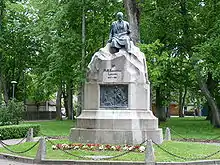Amandus Adamson
Amandus Heinrich Adamson (12 November 1855 in Uuga-Rätsepa, near Paldiski – 26 June 1929 in Paldiski) was an Estonian sculptor and painter.


Life
Born into a seafaring family, Adamson excelled in wood carving as a child. He moved to St. Petersburg in 1875 to study at the Imperial Academy of Arts under Alexander Bock. After graduation he continued to work as a sculptor and teacher in St. Petersburg, with an interruption from 1887 through 1891 to study in Paris and Italy, influenced by the French sculptors Jules Dalou and Jean-Baptiste Carpeaux.
Adamson produced his best-known work in 1902. His Russalka Memorial, dedicated to the 177 lost sailors of the Ironclad warship Rusalka, features a bronze angel on a slender column. The other work is architectural. His four allegorical bronzes for the Elisseeff department store in St. Petersburg (for architect Gavriil Baranovsky), and the French-style caryatids and finial figures for the Singer House (for architect Pavel Suzor) are major components of the "Russian Art Nouveau" visible along Nevsky Prospekt.
He was named an academician of the Imperial Academy in 1907. In 1918, in the context of the Russian Revolution and the Estonian War of Independence, Adamson returned to his home town of Paldiski in northwestern Estonia, where he spent the rest of his life.
Selected works
The work of Adamson varies in style and material. He sculpted monuments in Estonia, Saint Petersburg and the Crimea, as well as architectural sculpture, allegorical figures, and portraits.
- Fisherman from the Island of Muhu (plaster, 1892)
- In Anxious Expectation (bronze, 1897)
- allegorical sculptures of Commerce, Industry, Science and Arts on the façade of Elisseeff Emporium in St.Petersburg (bronze, 1902)
- The Russalka Memorial, Kadriorg (1902)
- allegorical sculpture for the Singer House, St. Petersburg (1902–1904)
- Tšempion (English: Champion), bronze sculpture of Estonian strongman Georg Lurich (1903)[1]
- Boats Lost at Sea, Sevastopol (1904)
- Memorial to Estonian painter Johann Köler, Suure-Jaani Cemetery (1912)
- Monument to the Estonian War of Liberation (1928, destroyed 1945)
- Monument to the Estonian poetess Lydia Koidula, Pärnu (1929)
Gallery
 Copy of the original Monument to the Estonian War of Independence, Kuressaare
Copy of the original Monument to the Estonian War of Independence, Kuressaare The Ship's Last Sigh, in bisque, 1899
The Ship's Last Sigh, in bisque, 1899 Sailors of the Ironclad warship Russalka
Sailors of the Ironclad warship Russalka finial figures and globe, Singer House. St. Petersburg, 1902–1904
finial figures and globe, Singer House. St. Petersburg, 1902–1904 Monument to the Scuttled Ships, Sevastopol, Crimea, 1905
Monument to the Scuttled Ships, Sevastopol, Crimea, 1905 Memorial to Estonian painter Johann Koler, Suure-Jaani Cemetery, 1912
Memorial to Estonian painter Johann Koler, Suure-Jaani Cemetery, 1912 Monument to the Estonian War of Independence, Pärnu, 1922
Monument to the Estonian War of Independence, Pärnu, 1922 Monument to Friedrich Reinhold Kreutzwald, Võru, 1926
Monument to Friedrich Reinhold Kreutzwald, Võru, 1926 Monument to Lydia Koidula, Pärnu, 1929
Monument to Lydia Koidula, Pärnu, 1929